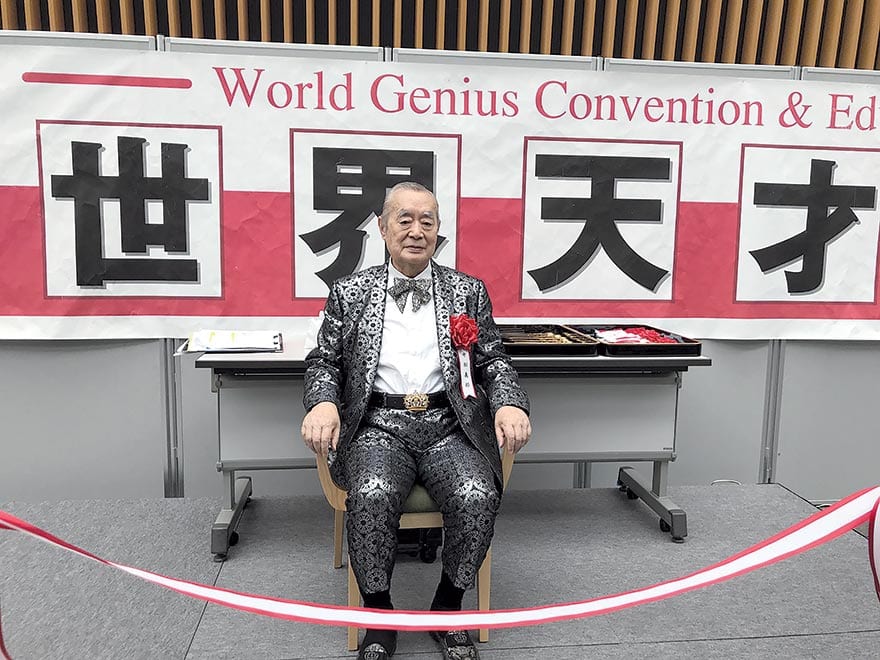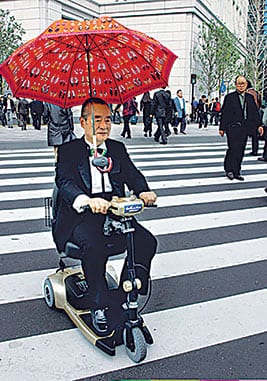Japan has a storied history of technical wizardry, but even then Yoshiro Nakamatsu (born 1928) stands out as a cut above the rest. Better known as Dr NakaMats, he’s a celebrity inventor who claims to have held over 4,000 patents, which would be a world record. He’s known for his loopy, goof-ball demeanour, which makes him something of a cross between Nikola Tesla and Willy Wonka
Japan’s most prolific, and bizarre, inventor, Yoshihiro NakaMats has a repertoire of inventions that spans everything from the useful to the ridiculous. Thousands of pages of neatly handwritten notes and diagrams document the man’s mental journey, and prototypes of the gadgets he invented—the magnetic strip, a computer-calculated putter, the aerial duster, jumping shoes, an anti-gravity float-vibrate 3D sonic system—are stacked against the walls of his Invention Library, which he sometimes opens to the public.

He used to invite 50 students a month into his Innovation House, where he teaches classes like Exercising the Imagination and The Logic of Invention. He also made his male model debut at a Tokyo runway show, while he claims to have 3,350 patents (Thomas Edison only had 1,093) and that several of them are for the floppy disk, a love potion more effective than Viagra that would reverse the declining birth rate, and a new water-to-fuel technology that fights global warming. The weird thing is that he could be telling the truth.
Dr NakaMats is the son of a banker, Hajime Nakamatsu, and a teacher, Yoshino Nakamatsu, who provided him with early tutoring in mathematics and science and encouraged him to begin inventing. He studied engineering at the University of Tokyo and today has three adult children and a personal net worth of 50 million U.S. dollars.
He was awarded the Ig Nobel Prize for Nutrition in 2005, after photographing and retrospectively analysing every meal he’d eaten in a project dating back nearly 40 years
According to the man himself, he came up with his first invention at the age of five and has been building gadgets ever since. His inventions range from the downright crazy to the surprisingly useful, while he’s built things like spring-loaded shoes, a self-defence wig and the particularly zany “Cerebrex” armchair. He also claims to have invented the floppy disk for IBM, though he says that the details of his agreement with the IT giant remain confidential.
NakaMats attributes his prolific output to a routine that’s every bit as eccentric as his inventions. He wakes up at 8am every morning in his Innovation House—an elaborate, three-storey, zero-carbon-emission building at the heart of Tokyo—and eats breakfast. His meals are a constant rotation of 55 foods he has deemed optimal for longevity and creativity based on 35 years of documenting his own dietary habits and correlating them to inventive output (it was NakaMats’s meticulous culinary research that won him the Ig Nobel Prize for Nutrition in 2005.) He then retreats to his home office for most of the workday, often listening to Beethoven’s Symphony No. 5 — the inspirational tune that he says spawned the floppy disk “Aha!” moment some sixty years ago.
His meals are a constant rotation of 55 foods he has deemed optimal for longevity and creativity based on 35 years of documenting his own dietary habits and correlating them to inventive output (it was NakaMats’s meticulous culinary research that won him the Ig Nobel Prize for Nutrition in 2005.) He then retreats to his home office for most of the workday, often listening to Beethoven’s Symphony No. 5 — the inspirational tune that he says spawned the floppy disk “Aha!” moment some sixty years ago.
Framed photographs of the inventor with everyone from the King of Sweden to the late emperor of Japan line the walls, alongside letters from foreign dignitaries—including one on White House letterhead from George Bush, Sr., sent circa 1988, praising him for his contributions to “technology that is so fundamental to the world’ s future prosperity, health, and peace”.
NakaMats doesn’t fall asleep until the break of dawn. “Midnight to 4AM is the golden time for invention. While everyone is sleeping, I’m thinking.”
 NakaMats spends his evenings jotting down inventive “flashes” on his Plexiglass notepad while hovering at the bottom of his private indoor pool. He claims that the moment he’s 0.5 seconds away from death unveils a part of his brain that’s inaccessible to an oxygen-infused brain. “Hundreds of inventions outside the realm of ordinary thinking have come to me in this environment,” he says. NakaMats doesn’t fall asleep until the break of dawn. “Midnight to 4AM is the golden time for invention. While everyone is sleeping, I’m thinking.”
NakaMats spends his evenings jotting down inventive “flashes” on his Plexiglass notepad while hovering at the bottom of his private indoor pool. He claims that the moment he’s 0.5 seconds away from death unveils a part of his brain that’s inaccessible to an oxygen-infused brain. “Hundreds of inventions outside the realm of ordinary thinking have come to me in this environment,” he says. NakaMats doesn’t fall asleep until the break of dawn. “Midnight to 4AM is the golden time for invention. While everyone is sleeping, I’m thinking.”
NakaMats didn’t become mayor of Tokyo, but he campaigned for Upper House elections by singing a parody version of Do-Re-Mi on street corners filled with youngsters and leaning out of his white election van, holding up his signature peace sign. He managed to rack up over 90,000 votes, landing him in the top 10 (of 20) candidates. He’s going to continue running for office, he says, because he has important technologies that could save Japan from destruction.
In any case, he stands tall as a legend of innovation and has been recognised as such. He was awarded the Ig Nobel Prize for Nutrition in 2005, after photographing and retrospectively analysing every meal he’d eaten in a project dating back nearly 40 years. He’s also not slowing down – by the time he dies at the age of 144 (an age he steadfastly states he will reach), he expects to have patented 6,000 inventions.